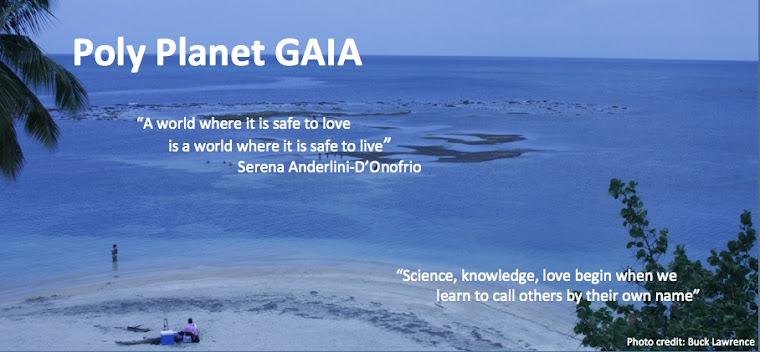Bi ReConNaissance: Introduction to BiReCon
Serena Anderlini-D'Onofrio
Cluster 5. Bisexual Cultural Productions, Interpretations, Reflections
The imagination is the realm of human life out of which new visions emanate, with their powerful reverberations across space and time. The fifth cluster includes contributions that discuss cultural constructions and interpretations of bisexuality in the social media, film, drama, and future life. These articles, and the sources they discuss, help us imagine how the world beyond the homo/hetero divide—this wide open world without binaries--would feel, look, read, and perform like.
“Blogging Bisexuals” is a social-media article that registers the experiences of two bloggers and their respondents to examine the role of blogging in the bloggers’ coming out process. Sue George is known to the public for her work on bisexuality. She also draws on her own experience as a blogger in this article. The blogosphere is a new realm of the imagination where love is signified. Its virtual character makes it more open to unconventional expressions and impulses. Its accessibility makes it a natural resource for “coming out” of one’s asphyxiating monosexual lifestyle. The two cases discussed show how the blogosphere served the purpose in different circumstances.
In “Bisexuality in the Cinema,” B.C. Roberts analyzes Anglophone film criticism discourse about bisexuality as mapped by critics who identify as bisexual. Robert reviews a vast array of secondary sources ranging over a fairly inclusive body of films with prominent bisexual tropes. Her claim is that this discourse has been shaped by dominant strategies for representing bisexuality. Roberts suggests a focus on the medium itself as a way to eschew this dominant bias.
 |
| Plays By Shakespare, Painting by Sir John Gilbert |
On a more hopeful note, Kaye McLelland proposes bisexual readings for a significant range of Shakespeare’s works, including plays and poems, in her multivoiced article, “Toward a Bisexual Shakespeare.” This is the kind of article any formally trained drama critic who honestly studies bisexuality would like to publish. Since my early days as an English major in my undergraduate career at the University of Sassari, Italy, I thought English literature was fabulous because its centerpiece, its cultural icon, was bi. That’s what really got me to continue in that field and specialize in drama! “Two loves I have” (# 144) is the sonnet I typically use to start off my workshops on bisexuality. The Bard declares he loves a “man right fair” and a “woman coloured ill,” I reason--who in the wide world could doubt he’s bi?
 |
| The "Bard" |
But obviously, my reasoning does not take into account the dynamics involved in the construction of national literary canons. What if English children found out at a tender age that a whole literary tradition is built on someone so “unpromotable” and “unreliable”? That’s where McLelland’s article helps out. The only reason why I can think so freely--I realize--is that I’m not a subject of the British Crown! McLelland enters the fray of this highly charged discussion with a gentle yet firm touch. She claims that bisexual readings of Shakespeare are realistic and plausible, with the added bonus of being--to bisexual readers--highly desirable. From her discussion, one gathers that the complexity and depth of understanding of bisexuality in Shakespeare’s oeuvre is such that it requires one to revisit all the meanings of bisexuality as they evolved in the modern era and became interrelated in culture and language.
 |
| Oberon, Titania, Puck, in Midsummer Night's Dream |
In this article, we observe that as a side effect of the homo/hetero divide, Shakespeare has been monosexualized one way or the other. McLelland’s discussion levels the playfield to where any actual bisexual interpretations of a specific work or set of works by the Bard will register as as legitimate as one based in any other sexual orientation. When it comes to a cultural icon around which so much in the ways of maintaining the status quo is invested, that is to say a lot! Last but not least, Hartmut Friedrichs’ “Politics Strategy: Bisexual or Queer” envisions transformative goals for bisexuality that affect a whole range of areas in human life, and discusses strategies that may be effective in timeframes ranging from the present to a whole century from now.
To be be continued: 8 of 8 - Conclusion. Watch out for this exciting section in a few days!
Copyright and Prepublication Notice:
© Serena Anderlini-D'Onofrio, transferred to Taylor & Francis for upcoming publication in BiReCon, a selected proceedings issue of the Journal of Bisexuality. Prepublished here courtesy of T & F. Stay tuned for volume and buy it online!
Read the Journal of Bisexuality online, the only peer-reviewed journal dedicated to the study of all aspects on bisexuality. Check out our latest: a provocative special-topics issue on Bisexuality and Queer Theory!






